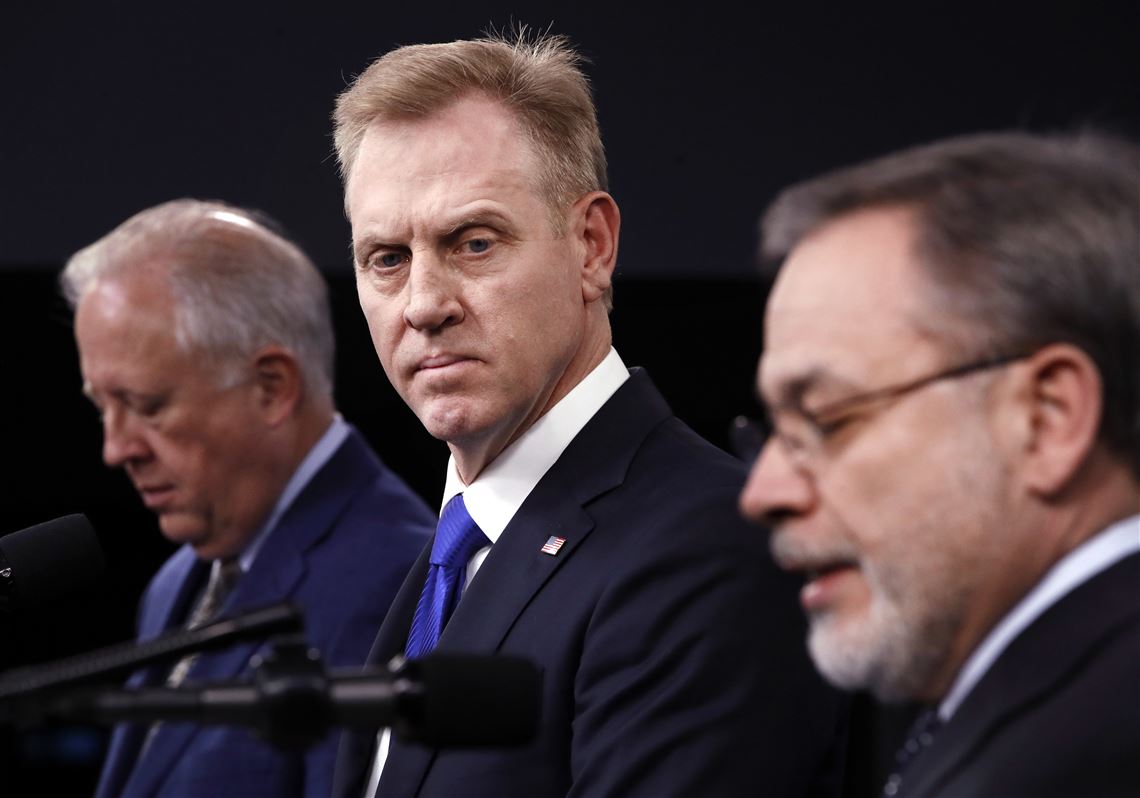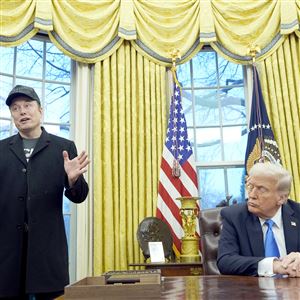WASHINGTON — The Trump administration outlined sweeping changes in U.S. nuclear strategy Friday, calling for two new types of nuclear weapons and warning for the first time that in “extreme circumstances” the U.S. could use nuclear weapons in response to non-nuclear attacks on infrastructure and civilians.
The strategy, described in a 75-page review released by the Pentagon, constitutes one of the most significant revisions of U.S. nuclear strategy since the Cold War, one aimed at aggressively countering nuclear-armed Russia and North Korea as well as terrorist groups seeking to acquire nuclear arms.
Though the strategy continues much of the previous administration’s nuclear weapons policy, it effectively ends Obama-era efforts to reduce the size and scope of the U.S. arsenal and minimize the role of nukes in defense planning.
It also takes a more aggressive stance toward Russia.
By clarifying potential scenarios when the president might authorize a nuclear attack, officials said, the U.S. was seeking to deter adversaries from conducting large-scale cyber warfare and other non-nuclear but potentially devastating attacks on the U.S. and its allies, a controversial idea that critics said could make nuclear war more likely.
“We must look reality in the eye and see the world as it is, not as we wish it to be,” Defense Secretary Jim Mattis said in a statement accompanying the report. “Given the range of potential adversaries, their capabilities and strategic objectives, this review calls for a flexible, tailored nuclear deterrent strategy.”
“In no way does this approach lower the nuclear threshold,” Mattis wrote. “Rather, by convincing adversaries that even limited use of nuclear weapons will be more costly than they can tolerate, it in fact raises that threshold.”
But Joseph Ciricione, a nonproliferation expert at the Ploughshares Fund, a Washington-based advocacy group that seeks reductions in the nuclear arsenal, said the new strategy — combined with President Donald Trump’s volatile approach to international threats — could lower the threshold for employing nuclear weapons.
“This strategy gives him a massive rebuild of the current Cold War arsenal, complete with new missions and new weapons, to include responding to a cyberattack with a nuclear bomb,” Cirincione said. “This plan, coupled with this president, greatly increases the risk of nuclear war.”
The Obama administration sought to shrink the role of nuclear weapons in U.S. defense strategy, hinging its policy on what the former president called a moral obligation for the United States to lead by example in ridding the world of nuclear weapons. It declared in 2010 that it would consider using nuclear weapons only in extreme circumstances, such as a massive conventional attack by a nuclear armed state or in the event of a mass-casualty chemical or biological attack.
Trump’s strategy likewise calls for using nuclear weapons only “in extreme circumstances to defend the vital interests of the United States, its allies and partners.”
But it specifies that extreme circumstances also could include “non-nuclear strategic attacks” including those on the “U.S., allied or partner civilian population or infrastructure,” as well as “on U.S. or allied nuclear forces, their command and control, or warning and attack assessment capabilities.”
Jon Wolfsthal, director of the Nuclear Crisis Group and a National Security Council official in the Obama administration, said the new strategy opened the door to first use of nuclear weapons by the U.S. in more scenarios than before.
‘The U.S. is expanding the circumstances under which it might use nuclear weapons first, even against non-nuclear states,” he said.
Officials in the Trump administration and the U.S. military argue that the former president’s approach proved overly idealistic, particularly as Russia re-emerged as a foe, and failed to convince U.S. nuclear adversaries to follow suit.
“Over the course of the last several years, Russia and China have been building new types and kinds of nuclear weapons, both delivery systems and actual warheads,” Air Force Gen. Paul Selva, vice chairman of the Joint Chiefs of Staff, told journalists earlier last week. “We have not, which means the capability of Russian and Chinese nuclear arsenals is actually getting better against ours.”
The new nuclear weapons policy follows Trump’s vow during his State of the Union address Tuesday to build a nuclear arsenal “so strong and powerful that it will deter any acts of aggression.”
The Trump administration Friday said Russia must be convinced it would face “unacceptably dire costs” if it were to threaten even a limited nuclear attack in Europe.
Its review recommends modifying “a small number” of existing nuclear warheads on Trident missiles carried on U.S. submarines to reduce the weapons’ explosive power. In addition, a new nuclear-armed cruise missile launched from naval vessels would be developed, a process likely to take years.
Both steps, the report says, are aimed at deterring “regional aggression,” including a decision by Russia, North Korea or other adversaries to carry out a limited nuclear strike in the belief that the U.S. would not respond because it did not want to risk large-scale nuclear war.
The Pentagon’s nuclear review concluded that while arms control can advance American interests, “further progress is difficult to envision,” in light of what the U.S. considers Russia’s aggression in Ukraine and violations of existing arms deals. Administration officials briefed Russian and Chinese officials Friday prior to the review’s public release.
The administration’s view is that Russian policies and actions are fraught with potential for miscalculation leading to an uncontrolled escalation of conflict in Europe. It specifically points to a Russian doctrine known as “escalate to de-escalate,” in which Moscow would use or threaten to use smaller-yield nuclear weapons in a limited, conventional conflict in Europe in the belief that doing so would compel the U.S. and NATO to back down.
Friday’s report endorsed adhering to U.S. arms control agreements, including the New START treaty that limits the United States and Russia each to 1,550 strategic nuclear warheads on a maximum of 700 deployed launchers.
The U.S. government says it has been in compliance since August and expects Moscow to comply by the deadline, which is Monday.
“Recent Russian statements on this evolving nuclear weapons doctrine appear to lower the threshold for Moscow’s first-use of nuclear weapons,” the review said.
Current and former Pentagon officials said that Russian military doctrine increasingly envisions using a limited nuclear strike to win a conflict in Europe, believing the U.S. and it allies might not want to risk large-scale nuclear war under those circumstances.
“We need to figure out how to deter a Russia military, which evidently believes it can use nuclear weapons to end and win a conventional conflict,” said Franklin Miller, a National Security Council official during President George W. Bush’s administration.
The lower-yield warhead for Trident missiles would “ensure a prompt response option” and would help counter any “mistaken perception” by Russia, North Korea or other adversaries that the U.S. might hesitate to respond with nuclear weapons to a limited nuclear strike by one of them, the report said.
Critics say the U.S. arsenal, which includes hundreds of lower-yield nuclear warheads, is adequate to deter any adversary.
“It lowers the threshold for using nuclear weapons, a particularly frightening proposition given this president’s support for a nuclear arms race,” said Sen. Dianne Feinstein, D-Calif. “Previous administrations, both Republican and Democrat, have worked to reduce the threat of nuclear weapons, and this review breaks sharply from that bipartisan tradition.”
During the Cold War, the Pentagon had sea-launched cruise missiles, which are more difficult for an adversary to detect because they fly at low altitudes. That weapon was retired by the Obama administration in 2011.
“Some will say any additional capacity, no matter how measured, increases the chances of using one of these weapons,” Deputy Defense Secretary Patrick Shanahan said Friday at a Pentagon news conference. “On the contrary, it is the exact opposite.”
The plan, the first review of the U.S. nuclear strategy since 2010, reaffirms many long-standing tenets of U.S. nuclear weapons strategy. That includes a promise made by the Obama administration to overhaul the nuclear arsenal by spending more than $1 trillion over the next two decades on new or modernized intercontinental ballistic missiles, bombers, submarine and warheads.
It also maintains the option for the U.S. to use nuclear weapons in a first strike, while not clarifying the exact conditions under which the president might do so. The Cold War-era policy was aimed at deterring Moscow and other adversaries and reassuring allies in Europe and Asia that the U.S. will come to their defense.
The option to develop the new cruise missiles could be reconsidered, the strategy says, if Russia removes a cruise missile of its own that the U.S. argues it has secretly deployed in violation of an arms control agreement, a claim Moscow denies.
Elisabeth Braw, a London-based nonresident scholar with the Atlantic Council, a foreign policy think tank, said Trump’s strategy was likely to reawaken Cold War fears in Europe that it could become a nuclear battleground in a U.S.-Russia conflict.
“We thought that had ended,” she said. “It feels like that specter is coming back.”
The press secretary at the Russian Embassy in Washington, Nikolay Lakhonin, did not immediately respond to a request for comment. But China on Sunday criticized the U.S. government report that cast Beijing as a potential nuclear adversary and called on Washington to reduce its own much larger arsenal and join in promoting regional stability.
A Defense Ministry statement said China’s nuclear arsenal is the “minimum level” required for security. It pledged never to be the first to use nuclear weapons “under any circumstances.”
The Associated Press and The Washington Post contributed.
First Published: February 4, 2018, 11:39 p.m.














